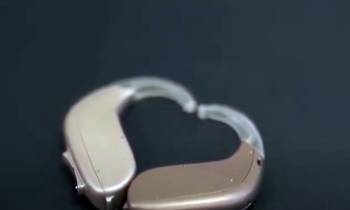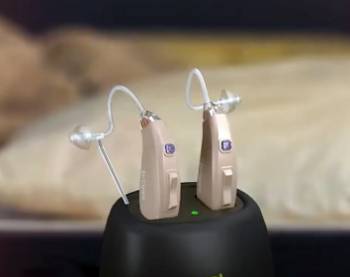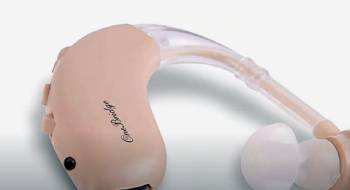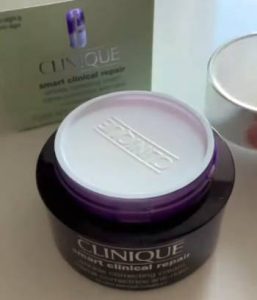If you’re struggling with hearing loss but aren’t ready to spend thousands on prescription hearing aids, EarCentric might be the perfect solution. These rechargeable, over-the-ear hearing aids promise clear sound, easy operation, and long-lasting battery life. After testing them out, I can confidently say they deliver where it matters most.
From improved speech clarity to effective noise filtering, EarCentric offers features that make everyday conversations and TV watching much easier. If you’re looking for an affordable yet high-performing hearing aid, this one is worth considering. Let’s break down what makes EarCentric stand out and whether it’s the right fit for you.
What Makes EarCentric Hearing Aids Worth Considering?

There are countless hearing aids on the market, but not all of them provide the right mix of quality, comfort, and affordability. EarCentric hearing aids bring several benefits that make them a solid choice.
- Fast Charging and Long Battery Life: One of the biggest frustrations with traditional hearing aids is constantly changing batteries. EarCentric eliminates that hassle with a rechargeable battery that lasts up to 20 hours on a single charge. I found this feature incredibly convenient—just charge them overnight, and they’re ready to go for the entire day.
- Clear and Natural Sound: Some hearing aids tend to amplify all sounds equally, making background noise overwhelming. EarCentric, however, filters out unwanted noise while enhancing speech clarity. I noticed a big difference when watching TV—no more turning the volume up too high just to understand conversations.
- Easy to Use and Adjust: Unlike some high-tech hearing aids that require smartphone apps or complex settings, EarCentric keeps things simple. The volume and mode adjustments are easy to access, making them a great option for seniors or anyone who prefers straightforward controls.
- Comfortable Fit for All-Day Wear: I’ve tried hearing aids that felt bulky or caused discomfort after a few hours. That wasn’t the case with EarCentric. The lightweight design and soft ear domes made them comfortable enough to wear all day, even with glasses.
Who Should Consider EarCentric Hearing Aids?

EarCentric hearing aids are ideal for individuals with mild-to-moderate hearing loss who want an affordable and effective solution without the hassle of expensive prescription models.
If you struggle to hear conversations clearly, frequently ask people to repeat themselves, or find yourself increasing the TV volume to uncomfortable levels, these hearing aids can make a significant difference.
They’re particularly well-suited for seniors or those who prefer a simple, user-friendly device with easy volume adjustments and no complicated settings. Unlike many in-ear hearing aids that can feel uncomfortable or cause excessive feedback, EarCentric’s over-the-ear design ensures a secure fit and minimizes whistling noises.
This makes them a great option for those who wear glasses, as they don’t interfere with the frames. Additionally, if you’re looking for a rechargeable hearing aid that eliminates the need for constantly replacing batteries, EarCentric offers a convenient solution with a long-lasting charge that keeps you going throughout the day.
They’re also a solid choice for people who want enhanced speech clarity without excessive background noise amplification, making everyday conversations and activities like watching TV much more enjoyable.
However, if you require Bluetooth connectivity, app controls, or extensive sound customization, you may need a higher-end model. But for those who need a reliable, well-balanced, and budget-friendly hearing aid that delivers on performance and comfort, EarCentric is a smart choice that can help improve your hearing experience without breaking the bank.
How to Get the Most Out of Your EarCentric Hearing Aids?
To ensure you have the best experience, here are some tips to help you maximize the performance of your EarCentric hearing aids.
- Give Yourself Time to Adjust: If this is your first time using hearing aids, be patient. Your brain needs time to get used to processing amplified sounds. Start by wearing them for a few hours a day and gradually increase the time as you get comfortable.
- Find the Right Ear Domes: EarCentric provides different ear dome sizes to ensure a proper fit. I initially used the pre-installed domes but later switched to a smaller size for better comfort. A secure fit prevents sound leakage and improves overall performance.
- Use the Right Sound Mode: EarCentric hearing aids come with two sound filters—one for speech and TV, and another for loud environments. Experiment with both to see which setting works best in different situations.
- Charge Them Overnight: To avoid interruptions during the day, make it a habit to charge your hearing aids overnight. The fast-charging feature ensures they’re ready to use each morning.
- Clean Them Regularly:Wax buildup can impact performance, so clean your hearing aids regularly. Wipe them down with a soft cloth and use a small brush to clear any debris from the microphone and ear tube.
Pros and Cons of EarCentric Hearing Aids

Pros:
- Affordable alternative to expensive models: EarCentric delivers impressive sound quality without the high price of prescription hearing aids, making them a budget-friendly option.
- Easy to use: No complex apps or tech knowledge required; adjusting volume and settings is simple with one-hand operation.
- Rechargeable & long-lasting battery: A full charge provides up to 20 hours of use, eliminating the need for constant battery changes.
- Comfortable over-the-ear design: Unlike bulky in-ear models, these fit comfortably around the ear and work well with glasses.
- Effective noise filtering: Two filter settings help reduce background noise, improving speech clarity in conversations.
- Good for first-time users: A smooth transition into hearing aids without overwhelming adjustments.
Cons:
- Lacks advanced customization: Unlike premium brands with Bluetooth and app-based adjustments, EarCentric has limited fine-tuning options.
- No streaming or smart features: These don’t connect to phones for calls or music streaming, unlike some high-end models.
- Might take time to adjust: Users may need an adaptation period, especially if switching from no hearing aid or an in-ear model.
- Not as discreet as in-ear models: While compact, over-the-ear placement is still more visible than completely-in-canal alternatives.
- Noise cancellation isn’t industry-leading: While effective, it doesn’t match top-tier hearing aids that use AI for adaptive noise reduction.
Also Read: My Experience With Similasan Ear Drops
EarCentric Vs. Other Hearing Aids
- EarCentric Vs. Eargo
Eargo hearing aids are known for their completely-in-canal design, making them nearly invisible. While this appeals to those who prioritize discretion, it can lead to comfort issues and a higher likelihood of whistling or feedback. EarCentric, with its over-the-ear design, provides a more stable fit, especially for those who wear glasses. Eargo devices also require an app for customization, which may not be ideal for seniors or those who prefer a straightforward approach. While Eargo is more advanced in features, EarCentric is the better choice for those who want reliable, easy-to-use, and more affordable hearing aids.
- EarCentric Vs. Audien
Audien hearing aids are among the most budget-friendly options, but that comes with trade-offs. Many users report that Audien amplifies all sounds equally, leading to excessive background noise. EarCentric, on the other hand, provides noise filtering settings that help prioritize speech clarity, making conversations much more manageable. Another key advantage of EarCentric is its rechargeable battery, lasting up to 20 hours on a single charge, whereas Audien’s battery life is often less reliable. If cost is the only deciding factor, Audien might seem appealing, but for better sound quality and usability, EarCentric is the smarter pick.
- EarCentric Vs. Phonak
Phonak is a premium hearing aid brand with advanced features like Bluetooth connectivity and AI-powered sound adjustments. However, these high-tech capabilities come with a hefty price tag—often several thousand dollars more than EarCentric. While Phonak excels in customization and connectivity, EarCentric provides an excellent balance of quality and affordability. If you don’t need app controls or streaming features and simply want clear hearing with easy adjustments, EarCentric delivers without the overwhelming complexity or cost of Phonak.
- EarCentric Vs. Linner
Linner hearing aids, like EarCentric, are over-the-ear models, but they often fall short in terms of sound clarity and comfort. Some users find Linner’s sound processing a bit mechanical, whereas EarCentric offers a more natural listening experience. Another advantage of EarCentric is its ease of use—Linner requires more fine-tuning, which can be frustrating for first-time users. Both brands provide noise reduction features, but EarCentric’s filtering is more effective in loud environments. If you’re looking for a reliable hearing aid that doesn’t require constant adjustments, EarCentric is the better choice.
- EarCentric Vs. MDHearing
MDHearing is another budget-friendly alternative, but it lacks the refined noise filtering and overall sound balance that EarCentric offers. While MDHearing devices can amplify sound, they tend to struggle with distinguishing between speech and background noise. EarCentric’s two filter settings make it easier to adapt to different environments without overpowering every sound. Additionally, EarCentric’s quick-charging capability provides a full day’s use, whereas some MDHearing models require frequent recharging. If speech clarity, comfort, and ease of use matter most, EarCentric is the better investment.
Also Read: My Experience With Earrck Hearing Aids
Frequently Asked Questions (FAQs)
The answer depends on your needs and budget. High-end prescription brands like Phonak and Oticon are often rated the best for overall performance. Among OTC hearing aids, EarCentric is highly rated for its affordability and sound clarity.
Prescription brands typically have the most advanced speech enhancement technology. However, among OTC options, EarCentric stands out for its ability to filter background noise and enhance conversations.
For seniors looking for ease of use, comfort, and affordability, EarCentric is an excellent option. Its simple controls and rechargeable battery make it a hassle-free choice compared to models with complicated settings.
Prescription hearing aids can cost anywhere from $1,500 to $6,000 per pair. High-quality OTC options like EarCentric typically range from $150 to $300, making them a much more budget-friendly alternative without sacrificing too much in performance.
Final Thoughts
After using EarCentric hearing aids, I can confidently say they offer great value for the price. The clear sound, effective noise filtering, and comfortable fit make them an excellent option for anyone with mild-to-moderate hearing loss. While they lack some advanced features like Bluetooth streaming, they more than make up for it with their affordability and ease of use.
If you’re tired of straining to hear conversations or constantly increasing the TV volume, EarCentric hearing aids could be the simple and effective solution you need. With their long battery life and hassle-free operation, they’re a smart investment in better hearing.



